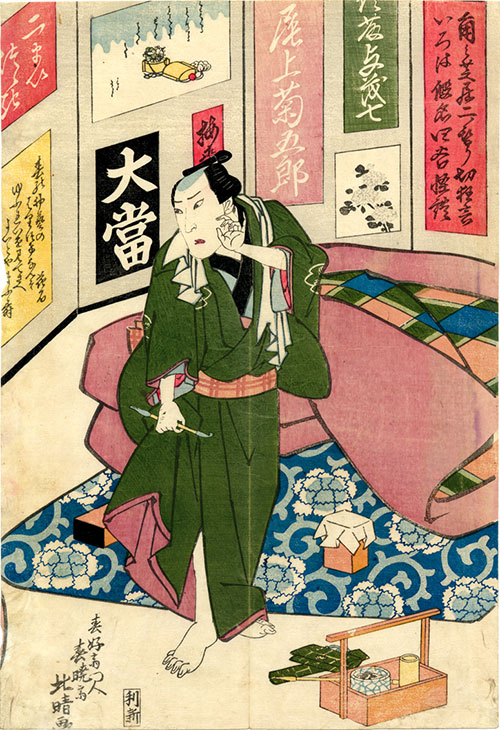Onoe Kikugoro III In Kamigata Ukiyo-e
June 3 (Tue), 2025‐August 31 (Sun), 2025
This museum exhibits ukiyo-e woodblock prints published in Osaka in the Edo period. Many of the ukiyo-e prints made in Osaka were portraits of kabuki actors performing in theatres around Dotombori, depicting how and what they played.
Generally, Kamigata-based actors performed in Dotombori theaters but not a few Edo-based popular actors also performed. One of them was Onoe Kikugoro III. He was among the most famous kabuki actors during Bunka-Bunsei period (1803-1840). ‘Tokaido Yotsuya kaidan’ which is the most famous and popular ghost story of all time in Japan, was written as a kabuki play for Onoe Kikugoro III.
Onoe Kikugoro III performed in Dotombori theaters many times and was depicted in Kamigata ukiyo-e. He is said to be very good-looking; there is an episode that he had praised himself as looking oneself in the mirror saying ‘why am I such an attractive man?’ Osaka ukiyo-e artists were said to depict actors more realistic than Edo artists did. Please enjoy the handsome actor in ukiyo-e.

Drawn by Hokusei
“Iroha gana Yotsuya kaidan”
Performed by Onoe Kikugoro III (playing the role of Sato Yomoshichi)
Onoe Kikugoro III and Kamigata
Onoe Kikugoro III (1784-1849) was a popular kabuki actor in Edo (present Tokyo) area and came to Osaka many times (in 1803, 1820, 1825, 1830, 1841 and 1848) to entertain Kamigata audience. His performances in ‘Iroha gana Yotsuya kaidan’ and ‘Sugawara denju tenarai kagami’ performed during his stay in Osaka from 1825 to 1826, were depicted in ukiyo-e prints.
In particular ‘Tokaido Yotsuya kaidan’, first performed in 1825 in Edo, was a big hit and ‘kaidan kyogen’ (ghost story) became his specialty. ‘Tokaido Yotsuya kaidan’ was played next year in Osaka under the title of ‘Iroha gana Yotsuya kaidan’. In exhibited ukiyo-e (Kikugoro playing Sato Yomoshichi), the word ‘big hit’ is written on the background byobu, showing the play was very popular also in Osaka.
He performed under the name of Okawa Hashizo when he came to Osaka in 1848 and died of illness on the way back to Edo.
Onoe Kikugoro III
Onoe Kikugoro III was born in 1784 into a joiner family. He was adopted by Onoe Matsusuke I (Onoe Shoroku I), a disciple of Onoe Kikugoro I. His first stage was in 1788 as Onoe Eizaburo I. In November 1809 he succeeded the name Onoe Matsusuke II when Onoe Matsusuke I became Onoe Shoroku I. In November 1814 he succeeded the name Onoe Baiko III from Onoe Kikugoro I and then succeeded the name Onoe Kikugoro III in the following year. He retired after he performed on stage stating ‘this performance is once in my lifetime’. Later he returned on stage under the name Okawa Hashizo and on April 24 in 1849, he died at Kakegawa on the way back to Edo from Osaka.
Bunka-Bunsei period (1804-1830) was a golden age of Edo kabuki world with many popular actors such as Ichikawa Danjuro VII. Onoe Kikugoro III was one of them and he performed a wide variety of roles from woman’s role to adult man’s role. He was good at playing a realistic life of common person (kizewamono) and also was skilled at quick change of clothes and performances with special effects.
Edo ukiyo-e artist Toyokuni depicted Onoe Kikugoro III as long face with a sharp outline and distinct facial features. He was said to be beautiful in a woman’s role. Please compare ukiyo-e prints of Kikugoro III produced by Kamigata artists with those produced by Edo artists.
Other Kikugoros after Kikugoro III
Eldest son of Onoe Kikugoro III succeeded the name Onoe Matsusuke III (playing Kariyahime in exhibited ‘Sugawara denju tenarai kagami’). Second son took the name Onoe Eizaburo IV but was said to die young. Onoe Kikugoro IV got married with eldest daughter of Onoe Kikugoro III and their adopted son became popular in Kamigata as Jitsukawa Enjaku I. Second daughter was married to Ichimura Uzaemon XII and their son took the name Ichimura Uzaemon XIII and later Onoe Kikugoro V.